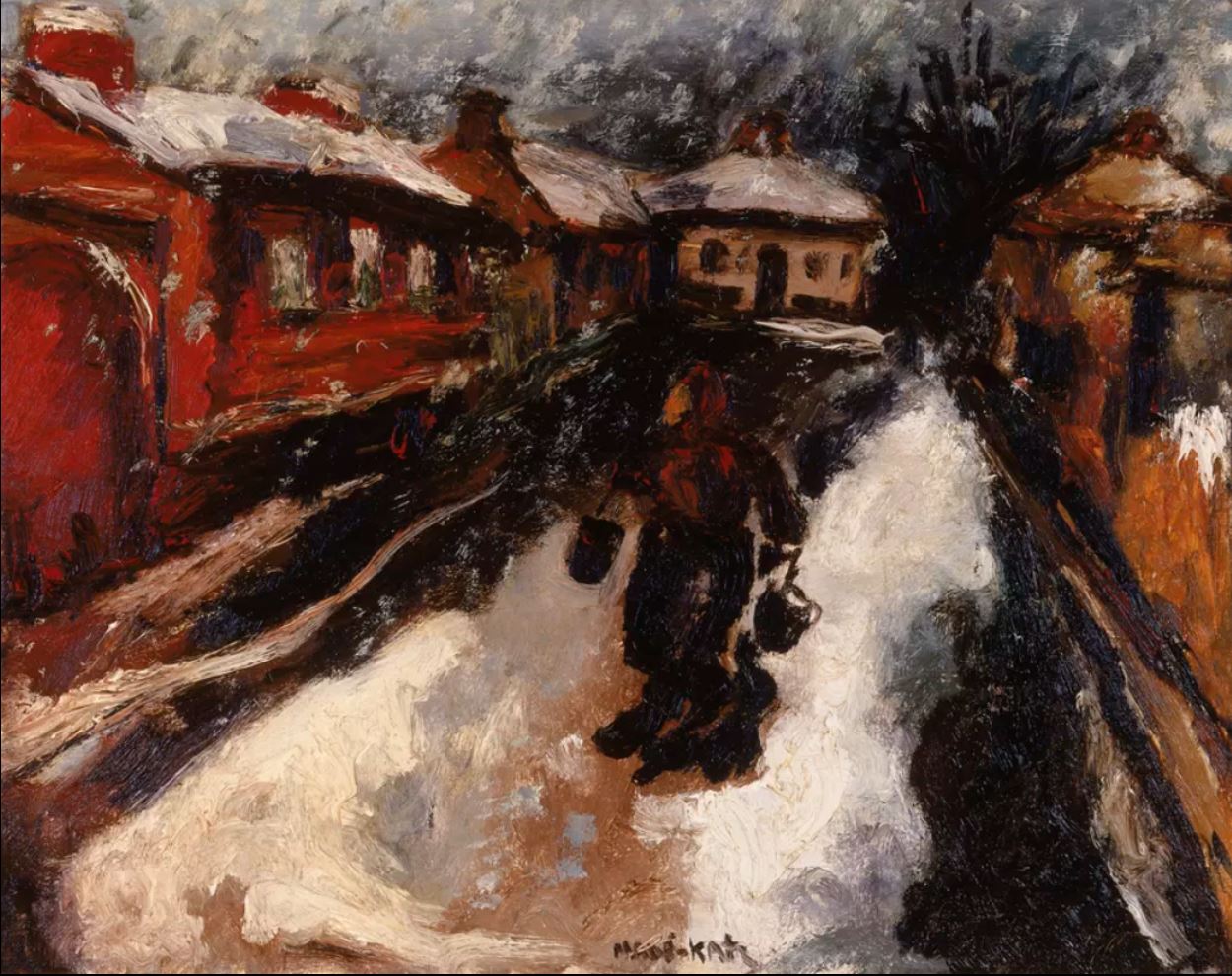In Kindergarten, I was assigned an at-home family heritage project. The project required that students work with their parents to put the flags associated with their heritage on a poster board in the shape of a shield to mimic a family crest. The kids in my class had projects covered in flags of Ireland, Poland, Italy, the UK, Korea and, of course, American flags for our present-day identities. Their ethnic backgrounds had clear and defined links to countries with these flags. Meanwhile, when I brought home this assignment, my parents couldn’t reach a quick and clear answer. “Well,” my mom speculated, “Zayda was born in Canada before moving to Philly at 4 years old, so we could put the Canadian flag? And I think our family is from Russia, so let’s put a Russian flag. I guess we should put the Israeli flag, too.” As a five-year-old, I didn’t question any of this. Looking back, I now know that my project greatly failed to represent my heritage.
As a 4th-6th generation Ashkenazi Jewish-American, my family is quite assimilated in the US. With that assimilation, the oral history of my family has become foggier with each generation. My parents and grandparents vaguely know their ancestors were Russian or Austrian Jews. My grandparents can name some cities their own grandparents were from: Kiev, Odessa, Bialystok. But “Russian Jew” does not mean Russia itself, and same with “Austrian.” The former empires of Russia and Austria-Hungary that existed around the time of my family’s immigration are now many different European countries, each with their own unique flag.
About a year ago, I became consumed with the desire to determine exactly where my ancestors immigrated from. I didn’t think it was Russia, I wasn’t sure it was Austria, it certainly wasn’t Israel (I think my family hasn’t lived there for at least a millennium), and a 4-year-long stint in Canada certainly doesn’t count as an ancestral homeland.
Based on the time of their immigration, between 1880 and 1920, I knew that the majority of my family likely lived in Eastern European shtetls. With this knowledge, I was not only motivated to learn definitive town names of where my ancestors were from but also to know the history of those towns. I can only assume my ancestors were the victims of pogroms because of where and when they lived. And like many other Jews, I feel the inherent epigenetic screaming of this intergenerational trauma (in the form of anxiety, of course). But, I wanted to have definitive events to ascribe that to, not just imagine that every minute of shtetl life looked like Fiddler on the Roof’s Anatevka. In my ancestral towns, did Jew and Gentile live side-by-side? Was there a specific pogrom or event that prompted my family’s immigration? With these questions in mind, I spent hours online doing research to trace each branch of my family tree to the exact location of their origin.
Even though my parents and grandparents could already tell me the names of my great, great-great, and great-great-great grandparents who immigrated to the US, I wanted to fully build my family tree on my own to be sure that no details were lost. In hindsight, I’m glad I decided to start from scratch because there were surprise name changes and other information we wouldn’t have recovered without my research. One disclaimer – these resources helped me, someone of entirely Ashkenazi Jewish lineage whose family came straight to the US from Eastern Europe during the Great Migration. I cannot guarantee that these resources are as useful for people whose families immigrated during other time periods or came from other parts of the world. Despite this, I hope that sharing my own research process and resources can serve as a model for those who don’t know where to start with their own Jewish family histories.
I used several online resources to build this family tree, the first being Ancestry. I had access to their wealth of documents through my academic institution’s subscription to Ancestry Library. If you don’t have access to an academic Ancestry subscription and don’t want to personally pay the fee to access their databases, make sure you’re prepared to do all of your research in the 14-day free-trial period. Ancestry has census records, naturalization documents, boat charters, draft cards from both World Wars, death certificates, marriage records, and more. Starting with my grandparents, I searched their names and slowly collected all documents pertaining to them before moving on to my great-grandparents, and so on and so forth. I double-checked birth date, death date, and any other relevant information, making sure it (approximately) matched on all relevant documents to be sure I was researching my relative. This is important if your relative has a common name in a densely populated area, for example, my great-grandfather Jacob Goldberg certainly wasn’t the only one with that name and I had to make sure I was reading documents about him.
Once I reached the “immigrant” of one of my lineages, I scoured all documents pertaining to them, searching for a specific place of birth. I found this information for different relatives in different places; sometimes a death certificate, frequently their naturalization record, sometimes on a draft card, and once on the charter for the boat they took to the US. Sometimes, the names of the places were straightforward, and one Google search showed me the city or town and even a Wikipedia page (I’m pretty sure no one is confused when they read “Kiev”).
Some places did not yield comprehensible Google results, and that’s when I used another important resource: the Communities Database by JewishGen. You can type in the name of the location as it’s written in your ancestry documents and the database will search through all shtetls with phonetically similar names in various languages, because each shtetl had names in different languages with different pronunciations. What my great-great-great grandfather’s draft card called “Gombin, Russia”, was also referred to as Gąbin or Gambin, Poland. You can click on the town for more information about the Jewish population that existed there, how the population grew and dwindled over time, find neighboring shtetls and links to other resources to learn more. Some shtetls have links to their respective Yizkor book, which is a memorial book that documents and commemorates life in a Jewish community that was destroyed in the Holocaust. But be aware—even if you find that your ancestral shtetls have Yizkor books, many are written in Hebrew or Yiddish without English translations.
There were certain lineages where I hit a dead end. I couldn’t find any documents for that relative naming a specific place of birth or town from which they had immigrated. In those cases, I turned to MyHeritage. I filled out my own family tree on my profile, and the “smart” feature of MyHeritage was able to match similarities in my tree to those of other users. The users who had matches to my tree were, of course, my distant relatives with interests in genealogy. Sometimes their family trees had information that mine was missing, whether that be because they found a document I had overlooked or they simply had a stronger oral history of their lineages. I was able to fill in a few missing pieces from the work of my distant relatives thanks to MyHeritage.
While I was not successful tracing all of my lineages, I did make many wonderful discoveries. My great-great grandmother was not, in fact, from Bialystok itself, as I had been told. She was from the Polish shtetl of Siemiatycze, once located in the Russian Empire. I learned that my “Austrian” lineage is actually my Galician-Jewish great-great grandparents from modern-day Kolomyia, Ukraine, once in the Austro-Hungarian Empire. My Zayda (technically great-Zayda) who was born in Canada? His parents came from the shtetl of Shpola, which today is in Ukraine but at the time was under the rule of the Russian Empire. I’ve since read more about Shpola and learned that it was the birthplace of Itzik Feffer, a Yiddish poet who was murdered by Stalin on the Night of the Murdered Poets.
All but one of my great-grandparents were born in the Western Hemisphere. The odd-one-out was born in Lukashivka, Ukraine. My research revealed that this great-grandfather had been living in “Kishineff, Roumania,” modern-day Chisinau, Moldova, before coming to the United States. I have since read about the Kishinev pogrom/Kishineff Massacre, one of the most horrific series of pogroms to occur before the Holocaust that took place in Kishinev in 1903 and 1905. Did my great-grandfather witness these horrors? How did that impact his life in Kishineff and his decision to immigrate? I will never know for sure. My dad and his siblings said that my great-grandfather never spoke about his life in the old world, and I can only imagine why not.
I still have a few loose ends to my research—if someone has a clue where “Noskovitz, Russia” is, noted twice in my great-great grandfather’s documents, please let me know—but I am overall immensely excited that I have documented some of the exact places my recent ancestors came from.
One downside to my work is that it stopped at my relatives’ birthplaces in Europe. The majority of the documentation I used was generated in the US, not Eastern Europe, because there was very little documentation generated in these shtetls at the time. Therefore, for me, the paper trail stops at the name of the city or shtetl. As of now, the only way I know how to reach back at least one more generation is to visit the headstones at my families’ graves, where I expect to read the Hebrew name of each individual, bar or bat, followed by their parents’ names. Through this, I can at least add one more level to my family tree.
So, what would I tell my 5-year-old self to do for this heritage project? While I now know my most recent ancestors came to the United States from modern-day Ukraine, Poland, Belarus, and Moldova, it doesn’t feel right to put those flags on my family-crest poster board. The Jewish life where my family once lived was decimated. They were not Ukrainian, Polish or Belarussian—just Ashkenazi Jews. And this is not only true for many Jews of Ashkenazi descent. We, Jews, are a diasporic people, hurled from one part of the world to another over the past several millennia. We fled across borders, were forced across borders, or borders changed around us while our cultures have persisted. There is no existing flag of any nation-state where Jews have lived that can capture the dynamicity and resilience of the Jewish diaspora. Thus, for our “heritage crests”, maybe a symbol would be more appropriate; perhaps Etz Chaim, or the Tree of Life, because the roots of our heritage are grounded in the culture we have carried with us across the globe.
Featured image “Russian Shtetl” by artist Mané-Katz, courtesy of the Jewish Museum.

